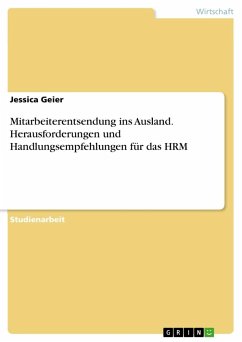
Reintegration of Expatriates
How to Ease the Re-entry Shock in Accordance with the Expatriate Cycle by Deploying a Relocation Service

PAYBACK Punkte
0 °P sammeln!
Seminar paper from the year 2013 in the subject Leadership and Human Resource Management - Miscellaneous, grade: 1,0, The FOM University of Applied Sciences, Hamburg, course: International Humane Resources, language: English, abstract: Internationalization is not a phenomenon of recent history. Having a closer look in ancient history Moor & Lewis state that they found 2000 before Christ the beginnings of multinational businesses with the Assyrians. Phoenicians, Greeks and Romans followed and a first peek was reached with the Silk Road. Ancient internationalization rose and declined wavelike in...
Seminar paper from the year 2013 in the subject Leadership and Human Resource Management - Miscellaneous, grade: 1,0, The FOM University of Applied Sciences, Hamburg, course: International Humane Resources, language: English, abstract: Internationalization is not a phenomenon of recent history. Having a closer look in ancient history Moor & Lewis state that they found 2000 before Christ the beginnings of multinational businesses with the Assyrians. Phoenicians, Greeks and Romans followed and a first peek was reached with the Silk Road. Ancient internationalization rose and declined wavelike in several phases. The emergence of the Hanseatic League coined the internationalization of the Middle Ages and was replaced by the families of merchants like Fugger and Medici. All these eras are characterized by international trade and travelling people.In the beginning of the following colonial era resources of colonies were exploited to manufacture and trade goods with the aim to strengthen the mother country. But with the decline of the colonial era and the rise of the industrial revolution foreign direct investment became a specific instrument as well as expatriate management.Today international travel is very common in business. The dimension of international business travel encompasses virtual foreign assignment, business trip, commuter, construction job, secondment, limited relocation and permanent relocation. IHRM is very well prepared to provide adequate trainings for all kinds of business travelers in respect to the cultural differences of the nation of destination. Although trainings for international assignments are rated as very good and good by 85% of the firms the attrition rate of expatriates/repatriates rose from 8% in 2011 to 12% in 2012 . Among those, 72% left the company during the assignment or within two years after returning from the assignment. This high attrition rate is not only a huge loss of internal and international knowledge for the company. In addition, to attract a new employee causes high costs, too. Furthermore, competitors engaging with these repatriates profit highly from their knowledge and gain a possible competitive advantage. This high attrition rate of expatriates/repatriates implies that there is a challenge within the repatriation process. Eventually, it raises the question whether the repatriation processes could be eased for repatriates.













